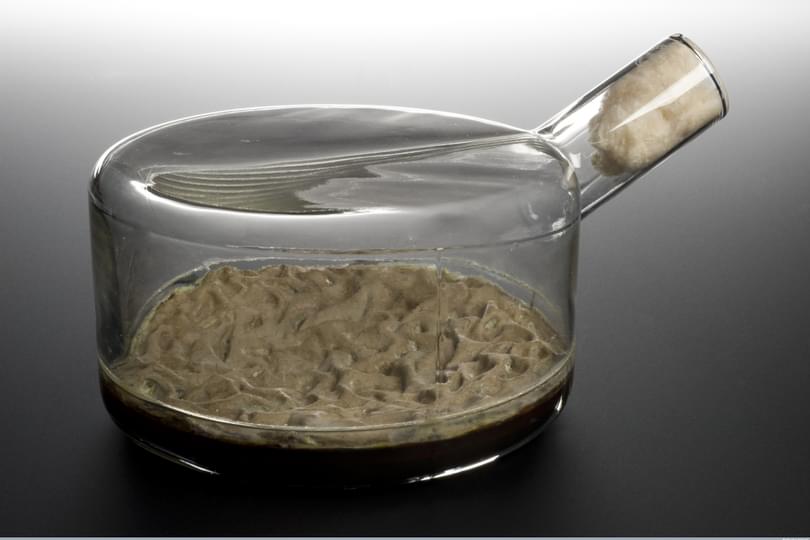
Seventy-five years ago, Oxford’s Radcliffe Infirmary on Woodstock Road was the site of a dramatic breakthrough. Beginning in February 1941, doctors injected several patients with a yellowish-brownish solution. The size of the needles and impurities made the injections extremely painful. Patients later compared the experience to having ‘boiling water’ injected into their bottoms. The results of the treatment were, however, miraculous. Within days, doctors reported startling recoveries of patients suffering from life-threatening bacterial infections. Penicillin, the active ingredient in the injected solution, soon became known as ‘yellow magic’. For the international team of penicillin researchers at Oxford’s William Dunn School of Pathology, news of the successful trials was extremely welcome. Since their discovery of a little-known 1929 paper by Alexander Fleming in 1939, the Oxford team had struggled to isolate and purify sufficient amounts of penicillin – the antimicrobial substance produced by the Penicillium chrysogenum (formerly notatum) mould – to treat patients. The successful conclusion of the 1941 clinical trials also convinced Allied decision-makers to support further penicillin work. By late 1941, penicillin had been taken to the US where additional ground-breaking research resulted in a dramatic upscaling of production. Allied propaganda posters soon celebrated penicillin as the product of innovative modern cooperation between science, industry, and the state. However, it did not take long for problems to emerge. As early as 1940, members of the Oxford team observed the development of bacterial resistance against penicillin in cultures of staphylococci. Unfortunately, this was not an isolated occurrence. Within a decade of penicillin’s mass-introduction, experts around the world were warning that overusing the new miracle drugs might soon eliminate their effectiveness.
The 75th anniversary of the first penicillin trials marks the starting point for the new Back from the Dead – Demystifying Antibiotics exhibition at Oxford’s Museum of the History of Science. The exhibition runs until May 2017 and was co-designed by members of the Oxford Martin School Programme on Collective Responsibility for Infectious Disease. For a medical historian, being asked to co-curate an exhibition like Back from the Dead is a fantastic chance to retell the dramatic story of penicillin development. It also offers the unique opportunity to challenge some of the myths surrounding antibiotics and to think about the wider cultural and political context of antibiotic use, bacterial resistance, and drug regulation.
As historian Robert Bud and biographer Eric Lax have pointed out, penicillin was subject to competing foundational narratives even before the Second World War was over. While St. Mary’s Hospital in London promoted Alexander Fleming as an individual genius who discovered penicillin, members of the Oxford team complained that Fleming had done little more than describe the antibacterial activity of a mould whereas they had turned penicillin into a viable medicine. Meanwhile, US researchers were irritated by the fact that their substantial contributions in transforming penicillin from a rare into a commonly available wonder drug were being overlooked. The award of the 1945 Nobel Prize in Medicine to Fleming and only two members of the Oxford team (Howard Florey and Ernst Boris Chain) caused further irritation. By the 1950s, the foundational myths surrounding penicillin resulted in bitter British complaints about American pharmaceutical companies’ successful marketing of a ‘British’ product and reinforced contemporary fears of an alleged ‘brain drain’ of British ideas and scientists to the US.
Back from the Dead sets out to challenge these narratives. Penicillin was not the work of an individual male genius, it was also not the result of an insulated national science environment, nor was it the first antimicrobial miracle drug to be marketed. The exhibition emphasizes that the penicillin story was part of a wider 20th century effort to isolate or synthesize therapeutic remedies, which would selectively target bacteria and leave human and animal cells unharmed. Drawing an analogy to Carl Maria Weber’s opera Der Freischütz, German chemist Paul Ehrlich had popularised the concept of selective therapeutic Zauberkugeln (magic bullets) from 1900 onwards. That such magic bullets were not a mere pipe dream seemed proven in 1909 when Ehrlich and his colleague Sahachiro Hata discovered Salvarsan (arsphenamine), the first effective – but rather toxic – remedy for syphilis. Observing the effects of the Penicillium mould in 1928, Alexander Fleming was thus working within a wider antimicrobial thought collective. Although penicillin turned out to be a remarkably effective substance, it was also not the first antibiotic to come into popular usage. Described by historian John Lesch, one of the most significant breakthroughs in antibiotic research occurred in 1932 when chemists and microbiologists working for the German company Bayer isolated the first of a new generation of miracle drugs called sulphonamides or sulpha drugs. Bayer’s Prontosil was marketed in 1935 and inspired the rapid development of a whole series of further effective sulpha drugs in Britain, France, and the US. The sulpha program of mass screening compounds for antibacterial activity and then modifying effective compounds to produce new drugs also provided an influential matrix for research on new fungal antibiotics. In 1939, the same year the Oxford group started work on penicillin, microbiologist Gerhard Domagk received the Nobel Prize in Medicine for his role in discovering Prontosil. Throughout the Second World War, it was far more likely that civilians and soldiers would be treated with a sulpha drug than with penicillin.
Back from the Dead also emphasizes that drug development at its most successful is a multi-disciplinary and international team effort. The exhibition notes that many important members of the Oxford team came from abroad: team leader Howard Florey was an Australian, the chemist Ernst Boris Chain was a German Jewish émigré, and a significant portion of the wider Oxford research community had international and refugee backgrounds. It is equally important to note that early penicillin work was not all-male either. During the war, a team of ‘penicillin girls’ proved vital in culturing the Penicillium mould in the Dunn School’s basement – often at the cost of developing penicillin allergies. Work on penicillin also profited significantly from research carried out by X-ray crystallographer Dorothy Crowfoot Hodgkin. In 1945, Hodgkin deciphered penicillin’s molecular structure and proved the importance of its b-lactam ring for antibacterial action. Later receiving the 1964 Nobel Prize in Chemistry for her determinations of important biochemical substances, Hodgkin’s work on penicillin was of great importance for understanding the mechanisms of bacterial penicillin resistance and for developing synthetic variants of penicillin.
Most significantly, however, Back from the Dead addresses the global challenge posed by the development of bacterial resistance against antibiotics. The exhibition uses recent surveys by the Wellcome Trust to challenge common misconceptions about bacterial antibiotic resistance and its causes. It also stresses that current resistance levels are being caused and sustained by antibiotic overuse. Following the Second World War, myth building and rudimentary understandings of bacterial resistance fostered not only overconfidence in existing miracle drugs but also in drug developers’ ability to keep ahead of bacterial resistance. Although researchers have known about bacterial resistance development since the sulpha drug era of the 1930s, early warnings were not enough to prevent the rise of antibiotic dependent systems in both human medicine and agriculture. By the late 1950s, hospital clinicians, general practitioners, veterinarians, farmers, and the general public had all come to rely on routine antibiotic use to keep bacteria in check. Despite repeated attempts to promote ‘rational antibiotic use’, improve hygiene measures, reduce consumer demand, and even restrict some antibiotics, regulators and activists have struggled to challenge post-war antibiotic complacency and dependency.

Above: An Allied VD poster, highlighting early resistance development and antibiotic overuse
Understanding the often deep-seated political, cultural, and economic reasons behind global antibiotic overuse poses a significant challenge for researchers in the humanities and social sciences. Back from the Dead attempts to contribute to solving this challenge. While the exhibition’s stories, objects, and bioart challenge contemporary antibiotic complacency, an embedded psychological study will produce new data on effective ways to communicate the risks posed by bacterial resistance. Devised by members of the Oxford Martin Programme on Collective Responsibility for Infectious Disease and run by Dr Andreas Kappes, the study confronts visitors with an ‘everyday’ medical scenario and seeks to elucidate ways in which medical practitioners can reduce patient demands for antibiotic prescriptions.
In sum, Back from the Dead not only retells one of medicine’s greatest 20th century triumphs but also warns that this triumph may well turn out to be temporary. Incorporating outreach programmes for local schools and projected to attract tens of thousands of visitors from all around the world, the exhibition also showcases the tremendous public engagement opportunities that museums offer to the wider research community.
- Main image: A pan containing Penicillium chrysogeum (formerly notatum).
- Images produced with kind permission of Wellcome Pictures
This opinion piece reflects the views of the author, and does not necessarily reflect the position of the Oxford Martin School or the University of Oxford. Any errors or omissions are those of the author.
